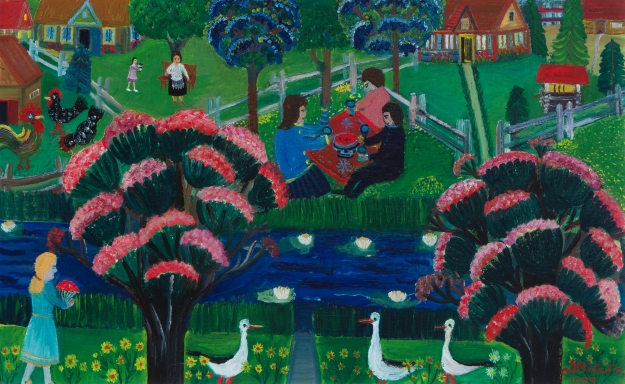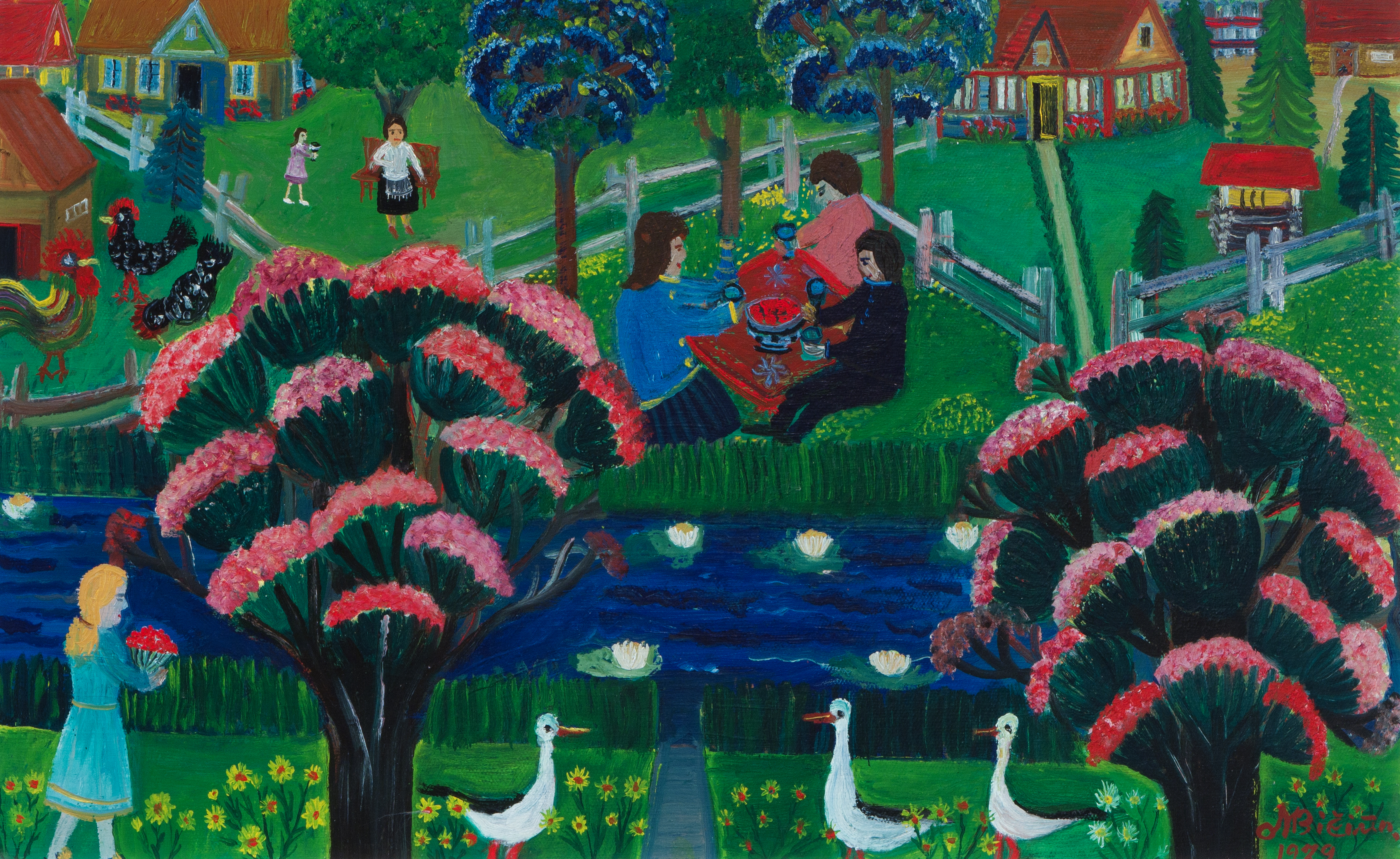Smiling art
Typologically, paintings by the self-taught artist Monika Bičiūnienė are attributed to naïve art. Their typical vitality, naivety, innocence and spontaneity make them classical textbook examples of naïve art. This type of art is characterised by bright colours, inaccurate presentation of perspective, deformed images, stiff and non-modelled human figures, planar space, primitive ways of portrayal and decorativeness. The plot varies a lot, because often the representatives of naïve art portray their own environment.
UždarytiThe term naïve art first appeared in the mid-20thcentury, even though the first exhibitions of such artwork were held as early as the beginning of the 20thcentury. At first their authors were referred to as ‘Sunday artists’, primitivists, amateurs, folk artists, etc. However, with time the term naïve art became the most acceptable way of referring to this type of art and it would be incorrect to refer to it as primitivism. Even though in terms of form naïve and primitive art could be interrelated, the purpose of the two types of art and reasons for creating it vary a lot.
Most of the primitive artwork is meant for magical, ritualistic and religious rites. This shows that such ‘artwork’has been created with a specific non-artistic purpose in mind and expresses a communal and collective worldview. At the same time, primitivism contains images that have been purposefully simplified by professional contemporary artists and supplemented with elements of pristine folk art, non-European cultures and child art. Naïve art, on the contrary, represents the worldview of a single person which is presented despite that person’s lack of academic skills. This is why the resulting figures are deformed, static, the space is planar, and the scale and perspective of paintings are ignored.
Naïve art, on the contrary, represents the worldview of a single person which is presented despite that person’s lack of academic skills. This is why the resulting figures are deformed, static, the space is planar, and the scale and perspective of paintings are ignored.
Monika Bičiūnienė’s artwork develops in a very even way. It is difficult to discern any dynamic elements in her paintings, because with time her style remains unchanged, unless her circumstances change and new topics appear, because they are always closely related to where and with whom the artist lives. This is how urban images ended up in the artist’s paintings after she moved to live in a city.
Bičiūnienė (1910–2009) had little or no formal education. She attended the first grade of primary school for a short time, but it was later that she learned to read and write when flipping through newspapers. Bičiūnienėentered the world of art unexpectedly at the age of 50 as encouraged by her son Rimas Bičiūnas, a painter, who in 1962 started his studies at Mikalojus Konstantinas Čiurlionis School of Arts and became his mother’s first teacher of art. ‘I painted with my windows fully covered and the doors locked. I did not want other residents of Pandėlis think that I had gone out of my mind,’she used to say.
In 1966, Bičiūnienė held her first painting exhibition at the National Library in Vilnius after which public recognition followed. In 1969, she moved to Vilnius and her artistic worldview, field of interests and topics widened, but she still preserved her fresh and optimistic outlook on the world.
In 1966, Bičiūnienė held her first painting exhibition at the National Library in Vilnius after which public recognition followed. In 1969, she moved to Vilnius and her artistic worldview, field of interests and topics widened, but she still preserved her fresh and optimistic outlook on the world. Bičiūnienėstarted visiting museums and exhibitions, communicating with people from the world of culture, including folk artists, and went to art camps and on tours.
With time, Bičiūnienė received international recognition. In 1984, two of her paintings were included in the World Encyclopaedia of Naïve Art published in Belgrade. Bičiūnienė was a surprisingly productive artist. She created over 2,000 paintings. Her artwork was exhibited in folk art exhibitions in Lithuania, England, Belgium, Czechoslovakia, Germany, Poland, Yugoslavia, Bulgaria, Hungary, Finland, India and the USA.
In terms of genre, Bičiūnienė’s artwork can be grouped into themed compositions, portraits and still lifes. Her painting Untitled is a rather typical example of rural environment as idealised by the author. It is full of fabulous blooming trees, celebrating women, footpaths leading to idyllic little houses, proud chicken, roosters and geese, and even a rivulet. The composition is rather primitive: the horizontal format of the painting is echoed by the motif of the river. The composition is almost symmetrical. The figures are placed at the very edge of the painting by enlarging the more important silhouettes without observing the rules of perspective. The whole painting is awash with green colour and spans across the wide scope of rural nature. Quite a number of elements in the painting are naïve, as if taken from a child’s drawing, and extremely flamboyant and decorative, which results in a sacrifice of realistic proportions and forms.
The world in her paintings is pure.’Bičiūnienė admires everything around her. She is not searching in agony, but rather looking around with a smile.
This is quite a different world from the one created in professional art. According to Vincas Kisarauskas, who wrote about the first artistic appearance of Bičiūnienė, ‘unlike our whole professional painting, which is problematic and complex in terms of painting, and complicated in terms of a multitude of intertwining speculations, trends, traditions and influences, Bičiūnienė’s artwork looks like a beautiful and fresh phenomenon created by an untouched soul. The strange thing is that all the tragedies and problems of our times, the enormous moral and physical difficulties that accompanied World War II, the post-war period, including all the changes, and finally all the hardships and troubles of personal life seemingly passed the painter by without essentially changing the artist’s spiritual construct. The world in her paintings is pure.’Bičiūnienė admires everything around her. She is not searching in agony, but rather looking around with a smile.




